In the constantly evolving landscape of digital marketing, there is a persistent quest for innovative tools that attract audiences and enhance user engagement. Among these emerging technologies, interactive content appeared as a powerful medium, offering a unique blend of visual appeal and functionality. In fact, an impressive 88% of marketers who have incorporated interactive content into their marketing strategies report that it has effectively set their brand apart from their competitors.
On that note, interactive maps are gaining significant traction. With their new functionalities, they are transforming traditional static maps, which lag behind in opportunities.
By integrating interactive elements, these maps go beyond mere location pinpointing to become immersive experiences that invite exploration and interaction. Integrating geographic data with interactive features enables businesses to tell compelling stories, showcase their products or services, and gather valuable insights into customer behavior.
As we take a closer look at interactive maps, it’s crucial to understand their mechanics, how they integrate with other digital marketing tools, and their potential to revolutionize the customer journey. From enhancing the user experience on websites and apps to providing insightful data analytics, interactive maps are redefining the boundaries of digital marketing.
This article explores the multiple roles of interactive maps in marketing, highlighting their functionality, impact, and the innovative ways they can be employed to create a more engaging and informative user experience.
How Interactive Maps Work
Understanding the significance of interactive maps in marketing requires an appreciation of the technology that drives them. These maps transcend mere static imagery, evolving into complex web applications crafted through the use of high-level programming languages such as JavaScript.
Interactive maps function by overlaying various layers of information on a base map. These layers can include locations, annotations, heat maps, or store locators. Users can interact with these elements by zooming in for detailed views, clicking on icons for more information, or adding customizable map markers.
The true power of interactive maps in marketing lies in their ability to engage and captivate audiences. Imagine a potential customer exploring a map that not only guides them through locations but also offers interactive elements like images or product information. This kind of engagement deepens the user’s connection with the brand, making the marketing experience more memorable and effective.
Choose the Right Mapping Tool
Selecting an appropriate mapping tool for your project is key to improving the user experience and gaining crucial insights. It’s important to consider factors such as the tool’s flexibility, user-friendliness, and ability to produce interactive maps.
For instance, a tool like Mapize emerges as an ideal candidate in this context. Mapize is renowned for its user-friendly interface and the ability to create highly interactive maps that can engage users and display complex data in an easily digestible format. It allows for customization of map features, including adding markers, layers, and various data points that can be interactively explored.
Additionally, its compatibility with different data formats and responsive design make it a versatile choice for various applications, from educational purposes to business analytics. By choosing to create interactive maps with Mapize, you’ll be able to tailor the mapping experience precisely to your specific needs while offering a dynamic and engaging user experience.
Interactive Maps and User Experience
The role of interactive maps in enhancing user experiences is immensely significant. In today’s digital landscape, where engaging users is key, interactive maps present a distinctive and captivating method to hold an audience’s attention. They transform the user’s experience from simply viewing to actively exploring, thereby creating a more memorable and engaging interaction.
These maps tap into the natural human desire for exploration and discovery. Users interacting with these maps are not merely viewing locations; they are on a journey of exploration. This could be a virtual tour of a property, navigating a complex mall, or tracing the origins of a product in an online store. Interactive maps turn these experiences into something that is both intuitive and absorbing.
A major advantage of interactive maps in enhancing user experiences is their capacity to deliver relevant information. Users can click on points of interest for additional details, view images, watch videos, or read reviews. This rich, context-driven interaction not only informs but also draws the user into the map’s narrative, an effective technique for marketing.
Analyzing Data With Interactive Maps
Source: Pexels
Interactive maps serve not only as a medium for visual engagement but also as a robust tool for data collection and analysis, offering essential insights into customer behaviors and preferences. In the marketing world, where data reigns supreme, interactive maps offer a distinctive perspective, enabling businesses to comprehend and engage with their audience effectively.
A major advantage of interactive maps in the context of data analysis is their capability to monitor user interactions. Each action on the map, be it a click, zoom, or other interaction, generates valuable data. This includes tracking user geographical patterns, identifying areas of the map that receive high engagement, and noting the most accessed information. Analyzing these data points allows marketers to better understand what interests users and how to refine their content to align with these interests.
Geographic data analysis is another vital aspect of interactive maps. Companies can utilize these maps to pinpoint market trends, demographic shifts, and consumer habits across various regions. Such detailed analysis proves especially advantageous for businesses aiming to venture into new markets or customize their marketing approaches for particular geographic locations.
Conclusion
Interactive maps represent a significant evolution in the digital marketing landscape, bridging the gap between location-based data and user engagement. As we have explored, these dynamic tools offer more than just geographical insights; they provide a platform for storytelling, user interaction, and in-depth data analysis. From enhancing the user experience to offering valuable data-driven insights, the potential of interactive maps in marketing is vast and largely untapped.
The key to successfully implementing interactive maps lies in understanding their capabilities, addressing the challenges head-on, and creatively integrating them into your marketing strategy. Whether it’s through enriching the user experience, personalizing content, or leveraging their data analysis capabilities, interactive maps can significantly boost marketing efforts.

















